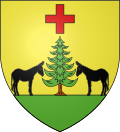world.wikisort.org - France
Azet is a commune in the Hautes-Pyrénées department in the Occitanie region of south-western France.
Azet | |
|---|---|
Commune | |
 The village, with Col d'Azet in the background | |
 Coat of arms | |
Location of Azet  | |
 Azet  Azet | |
| Coordinates: 42°48′41″N 0°21′09″E | |
| Country | France |
| Region | Occitania |
| Department | Hautes-Pyrénées |
| Arrondissement | Bagnères-de-Bigorre |
| Canton | Neste, Aure et Louron |
| Intercommunality | Aure Louron |
| Government | |
| • Mayor (2020–2026) | Maryse Puyau[1] |
| Area 1 | 26.63 km2 (10.28 sq mi) |
| Population | 143 |
| • Density | 5.4/km2 (14/sq mi) |
| Time zone | UTC+01:00 (CET) |
| • Summer (DST) | UTC+02:00 (CEST) |
| INSEE/Postal code | 65058 /65170 |
| Elevation | 1,055–3,020 m (3,461–9,908 ft) (avg. 1,172 m or 3,845 ft) |
| 1 French Land Register data, which excludes lakes, ponds, glaciers > 1 km2 (0.386 sq mi or 247 acres) and river estuaries. | |
The inhabitants of the commune are known as Azetois or Azetoises.[3]
Geography
Azet is located some 55 km south by south-east of Tarbes and 20 km west of Bagnères-de-Luchon. Access to the commune is by road D225 from Estensan in the west to the village. The public square of the village is 1,172 metres above sea level at the intersection of the Aure and Louron valleys with the Col de Val Louron-Azet to the south-east. The commune is very rugged and inaccessible with extensive forests in the south.[4]
The Ruisseau de Lustau flows north from the Lustou Lake in the south of the commune, gathering many tributaries including the Ruisseau de Sarrouyes which flows from lakes in the south-east of the commune, and becoming the Mousquere before passing the village and continuing north to join the Neste d'Aure north of Vielle-Aure.[4]
Climate
Azet has a mountain climate with high temperatures in summer.
Neighbouring communes and villages
Toponymy
The probable etymology of the name is Adet, adou, ados, âne, asou, then Azet meaning a place marking the end of the terrain which could only be crossed by donkey or horse.
History

There is little evidence to trace the origin of the village except the church, which dates from the fourth quarter of the 12th century[5] In 1887 the village had two primary schools. Village resources were mainly pastoralism with livestock farming of sheep, cows, horses, and donkeys as well as crops such as wheat, rye, meslin, barley, buckwheat, beans, peas, potatoes, turnips, flax sprouts, and hay.
From the 1880s the population decreased due to the waves of typhoid fever during 1886-1887 and the rural exodus of young people.
Heraldry
 |
These arms do not respect the rule of tincture and are therefore faulty.
Blazon:
|
Administration
This list is incomplete; you can help by adding missing items. (April 2021) |
List of Successive Mayors[6]
| From | To | Name | Party |
|---|---|---|---|
| 2001 | 2020 | Jean-Michel Carrot | PS |
| 2020 | 2026 | Maryse Puyau |
Population
|
| ||||||||||||||||||||||||||||||||||||||||||||||||||||||||||||||||||||||||||||||||||||||||||||||||||||||||||||||||||
| Source: EHESS[7] and INSEE[8] | |||||||||||||||||||||||||||||||||||||||||||||||||||||||||||||||||||||||||||||||||||||||||||||||||||||||||||||||||||

Culture and heritage
Civil heritage
The commune has a number of sites that are registered as historical monuments:
- Other sites of interest
- The Pyrenean House of Pastoralism is an educational and tourist centre on pastoralism in the mountains. The museum traces the history and development of pastoralism in France and worldwide.
Religious heritage

The Church of Our Lady of the Assumption (12th century)![]() is registered as an historical monument.[5][11] The Church contains a very large number of items that are registered as historical objects.[5][11]
is registered as an historical monument.[5][11] The Church contains a very large number of items that are registered as historical objects.[5][11]
See also
References
- "Répertoire national des élus: les maires". data.gouv.fr, Plateforme ouverte des données publiques françaises (in French). 2 December 2020.
- "Populations légales 2019". The National Institute of Statistics and Economic Studies. 29 December 2021.
- Inhabitants of Hautes-Pyrénées (in French)
- Google Maps
- Ministry of Culture, Mérimée IA00126577 Church of Our Lady of the Assumption (in French)

- List of Mayors of France (in French)
- Des villages de Cassini aux communes d'aujourd'hui: Commune data sheet Azet, EHESS. (in French)
- Population en historique depuis 1968, INSEE
- Ministry of Culture, Mérimée IA00126622 Houses and Farms (in French)
- Ministry of Culture, Mérimée IA00126612 Farmhouse (in French)
- Ministry of Culture, Mérimée PA00135468 Church of Our Lady of the Assumption (in French)
External links
- Azet on the old IGN website (in French)
- Azet on Géoportail, National Geographic Institute (IGN) website (in French)
- Azet on the 1750 Cassini Map
На других языках
[de] Azet (Hautes-Pyrénées)
Azet ist eine französische Gemeinde mit 143 Einwohnern (Stand 1. Januar 2019) im Département Hautes-Pyrénées in der Region Okzitanien (zuvor Midi-Pyrénées). Sie gehört zum Arrondissement Bagnères-de-Bigorre und zum Kanton Neste, Aure et Louron (zuvor Vielle-Aure).- [en] Azet
[ru] Азет
Азе́ (фр. Azet, окс. Àdet) — коммуна во Франции, находится в регионе Окситания. Департамент — Верхние Пиренеи. Входит в состав кантона Вьель-Ор. Округ коммуны — Баньер-де-Бигор.Другой контент может иметь иную лицензию. Перед использованием материалов сайта WikiSort.org внимательно изучите правила лицензирования конкретных элементов наполнения сайта.
WikiSort.org - проект по пересортировке и дополнению контента Википедии